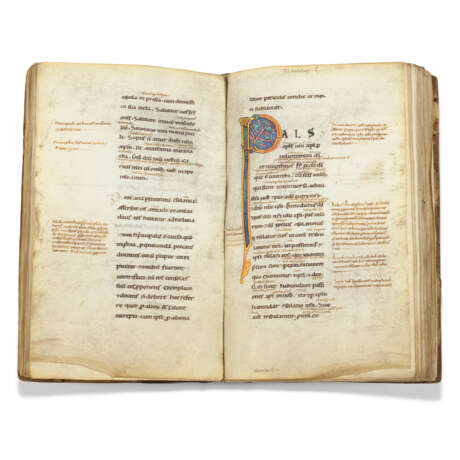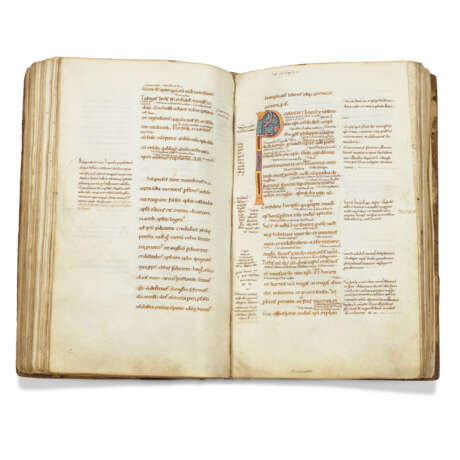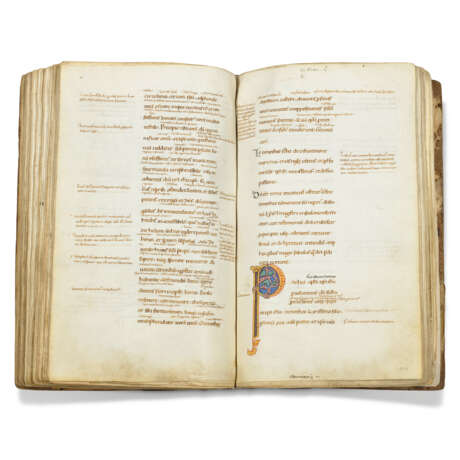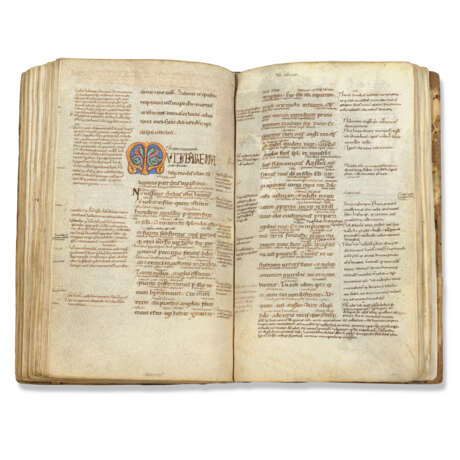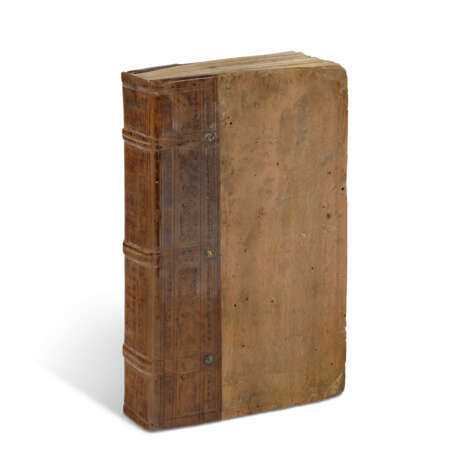ID 794422
Lot 21 | Pauline Epistles, glossed, in Latin, illuminated manuscript ...
Valeur estimée
£ 60 000 – 90 000
A splendid and early example of an important and popular text: the glossed Pauline Epistles, produced and illuminated in central Italy in the second half of the 12th century and surviving with its original medieval boards.
283 x 170mm. 128 leaves, collation: 16 (of 8, lacking iii and iv), 2-78, 84 (of 8, lacking iii-vi), 9-168, 176 (of 8, vi blank and viii cancelled), modern foliation in pencil 1-128 followed here, some horizontal catchwords survive, prickings survive, 23 lines of biblical text with interlinear and marginal glosses in a smaller script, both written in brown ink in a late Romanesque bookhand, ruled space: 187 x 67mm, some capitals in red, thirteen large painted floral initials extending into margins, several early glosses and additions in the margins, some glosses erased, pastedown on lower cover from a 12th-century scholastic manuscript, offsetting of old pastedown to upper cover (lacking single leaves after ff.2 and 4, four leaves after f.566 and 2 blanks at end, occasional fading to the text of some of the glosses, some worming at ends, some staining and cockling, repairs to opening and final leaves, affecting glosses, natural flaws to vellum, otherwise in good condition with wide margins). Contemporary binding of wooden boards (remains of a clasp on lower cover, traces of medieval title at bottom of upper cover, some worming, edges scuffed, repaired and rebacked, new endleaves by John Smart, 1989, with his label).
Provenance:
(1) The style of decoration and script is consistent with a 12th-century central Italian production. There is an erased ownership inscription on f.128v: ‘Huius liber? […]’.
(2) In France in the 19th century: enclosed note to a binder in French. There are some earlier annotations apparently in French in the margins, now illegible, e.g. on f.15-15v.
(3) Judge Walter Burges Beals (1876-1960), bibliophile and Chief Justice of the Washington Supreme Court (see S. de Ricci, Census of Medieval and Renaissance Manuscripts in the United States and Canada, II, 1937, p.2189, no 5), bought in 1931 from Erik von Scherling, Rotulus, I, 2 April 1931, no 1151, sold with other Beals manuscripts at Sotheby’s, 22 June 1982, lot 67 to Quaritch, for £6,600.
(4) The Schøyen Collection, Oslo and London, MS.18, purchased from Bruce Ferrini, cat.1 (1987), no 7; sold at Sotheby’s, 17 June 2003, lot 81.
Content: Pauline Epistles, with the Glossa Ordinaria, ff.1-128v: Romans (f.1), 1 Corinthians (f.25), 2 Corinthians (f.53), Galatians (f.64v), Ephesians (f.72), Philippians (f.80), Colossians (f.85v), 1 Thessalonians (f.90v), 2 Thessalonians (f.95), 1 Timothy (f.98), 2 Timothy (f.104), Titus (f.108v), Philemon (f.111v), Hebrews (f.112v).
The Glossa Ordinaria was one of the great achievements of the 12th century: a combination of the scriptural text interwoven with patristic and medieval commentaries used by students and teachers until the end of the Middle Ages, originally compiled under the direction of Anselm of Laon (d.1117) and his brother Ralph (d.1134), but gradually augmented over the decades that followed. Manuscripts of the Pauline Epistles with the Ordinary Gloss were not among the most commonly copied glossed books and their textual history, like that the Psalter – two of the texts most important for commentary tradition and theology – is complicated. After Anselm of Laon, the Ordinary Gloss of the Pauline Epistles was revised in two commentaries – one by Gilbert of Poitiers (see K. Froehlich, ‘Gilbert of Poitiers: Commentary on the Pauline Epistles’, CCCM, 2022), and then Peter Lombard (begun c. 1135, but not complete until 1155 or even 1158-9, when Lombard became bishop of Paris).
The layout of the manuscript corresponds to that used in the earliest glossed manuscripts: the biblical text was copied first in a large script in one central column, leaving room between the lines and in all four margins for glosses; the glosses were added as necessary, in a smaller script, and ruled separately (see C. de Hamel, Glossed Books of the Bible and the Origins of the Paris Booktrade, 1984, for the history of the format of glossed Bibles).
Decoration:
The style of decoration of the initials is still reminiscent of the ‘early geometrical’ style (according to the terminology of Edward B. Garrison) adopted in central Italian illumination of the 11th and 12th centuries, and the bright palette of yellows, reds and greens, with initials bordered in yellow, knotted at the top, and with leafy, foliate terminals, suggests a Roman or Umbrian production of the mid-12th century. The 2003 Sotheby’s catalogue drew parallels with a Bible in Paris (Bibliothèque nationale de France, mss Latin 50 and 104) and a manuscript of the Pauline Epistles (Bibliothèque nationale de France, ms Latin 312), but the style of the initials is closest to a Bible in Padova (Biblioteca del Seminario, ms 533): we see the same yellow and red bordering to the initials, and the same interlace patterns.
Special notice
No VAT on hammer price or buyer's premium.
| Lieu d'origine: | Italie, Europe |
|---|---|
| Catégorie maison de vente aux enchères: | Manuscrits médiévaux et de la Renaissance |
| Lieu d'origine: | Italie, Europe |
|---|---|
| Catégorie maison de vente aux enchères: | Manuscrits médiévaux et de la Renaissance |
| Adresse de l'enchère |
CHRISTIE'S 8 King Street, St. James's SW1Y 6QT London Royaume-Uni | |
|---|---|---|
| Aperçu |
| |
| Téléphone | +44 (0)20 7839 9060 | |
| Commission | see on Website | |
| Conditions d'utilisation | Conditions d'utilisation |
